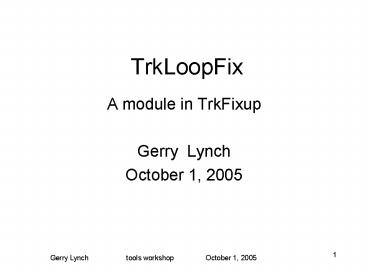TrkLoopFix PowerPoint PPT Presentation
1 / 14
Title: TrkLoopFix
1
TrkLoopFix
- A module in TrkFixup
- Gerry Lynch
- October 1, 2005
2
What is a Looper?
- Simple definition
- A track that goes at least a full turn in the
detector. - Alternate Definition
- A track that is fragmented into two or more
tracks, which share many layers. - Operational Definition
- Pairs of low momentum tracks that are 180 degrees
apart.
3
Looper Azimuth difference
- Before TrkLoopFix a selection is made that keeps
low momentum track pairs that are within 0.2
radians of 180 degrees in both azimuth and dip.
These go in the work list..
There is a small (7) background under the
peak.
4
Looper Sample
- We see that most of the tracks that are in the
looper sample are tracks that hit the outer wall
of the DCH. - The preselection for the work list used by
TrkLoopFix has a cut at 100 cm,
5
- Looper Multipicity
Most looper candidates have two tracks
The number of tracks for each looper size is
shown here.
6
Apogee, Parigee
- In the looper at the right,Track 1 is first.
- Tracks 1 and 2 form an apogee pair.
- Tracks 2 and 3 form a parigee pair.
- Our goal is to keep 1 and reject 2 and 3.
- The procedure for classifying the looper
candidates starts with labeling each pair as
apogee. perigee, neither, or either
In any looper pair one tracks is going out and
the other going in. But we fit the tracks as if
they were going out. So one is wrong.
7
Method 1
- When we plot Sum against Sum(d0), we See a clear
band of apogee pairs. - Very few are rejected.
- The vertical black band is a mixture of apogee
and perigee pairs.
8
Method 2
- In this plot of the calculated number of
turns from z02-z01, omega, and tanDip,we see
clear apogee and (impure) perigee bands at dip
angles above about 0.15. - The number rejected is small, but larger than for
method 1
9
Beam-line Chi-squared
- Pairs with both tracks primary are not loopers.
- Pairs with one track primary are probably apogee
pairs. - Note that many of the good apogee pairs have no
primary track.
10
Position Chi-squared
- We get chi-squareds for the comparison of the
orbits at parigee and apogee. - The full chi-squared is not very useful, but the
position component is valuable. - This shows how these chi-squared agree with
method 2 decisions. - This position chi-squared is used to classify the
pairs that were not decided before. -
11
Procedures
- The result of the classification of single pair
loopers is - 67 apogee 17 neither ( many of
these are not loopers) - 15 perigee 1 either
- For a single pair looper we keep the best track
and discard the other - for apogee and perigee pairs and keep both
for the others. - For multi-pair loopers the procedure is to choose
the best pair - by a formula that prefers the apogee pair
with the highest - momentum. If that pair is apogee or
parigee, the preferred track in that - pair is kept and all others rejected.
- For multi-pair loopers that are classified
either or neither, both - tracks in the highest momentum pair are kept.
12
MC Checks
- If our apogee pairs are right, the sign of
curvature will agree with the Monte Carlo truth. - The present program gets agreement with the MC
98 of the time, showing that the correct track
is is being selected. - For perigee pairs the fraction in the opposite
curvature sign is 61. I think that this
should be larger. - Another check is to compare fitted track
parameters, To do this one needs to pay
attention to the track direction and what sheet
of the helix the parameters represent.
13
MC Parameter Test
- The parameters of the tracks are compared with
the Monte Carlo truth. - There is excellent agreement. Multi-pair loopers
look almost as good.
14
Problems
- As indicated on the MC checks page, the
performance for parigee pairs is suspect. - One is tempted to conclude from the MC parameters
test that things are ok because when the
chi-squared is small the track was accepted. - But all the small chi-squareds are from tracks in
apogee pairs. The parigee pair tracks do not
have small chi-squareds, probably because they
are fitted in the wrong direction,. - One approach to this would be to fit all of the
parigee candidate tracks and work with two
possible solutions when searching for best
solution. - We will have to refit the retained perigee track
in any case because it is in the wrong direction.

